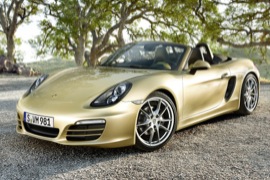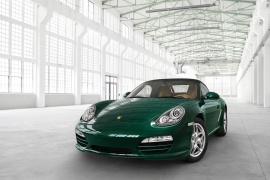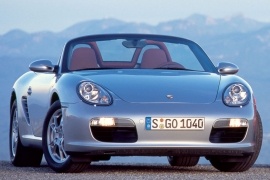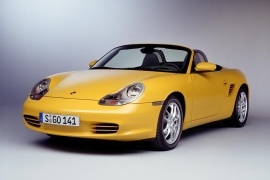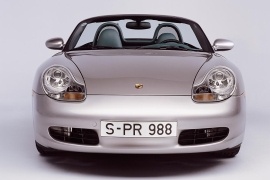PORSCHE Boxster Models/Series Timeline, Specifications & Photos
First production year: 1996
Engines: Gasoline
Body style: Convertible (spider/spyder, cabrio/cabriolet, drop/open/soft top)
Fifteen years have passed since the introduction of the Boxster in the Porsche lineup, and the German sports car maker had already launched the car's third generation at the 2012 Geneva Motor Show.
The world economy started to recover after the world financial crisis that began in 2008, and Porsche was one of the brands that survived that era. Other automakers were not that lucky and either closed their assembly lines or were on the brink of bankruptcy. Fortunately for the German sports car maker, sales of its vehicles were good enough, and the Boxster was one of the models that saved the brand. In addition, the 987 has already been on the market for eight years, and a new model was needed. As a result, the automaker launched the third generation of this moniker, bearing the unusual 981 coding in the factory system. It was lighter, bigger in all sizes, featured a smaller displacement engine, and was quicker than its predecessor. Last but not least, it was more fuel efficient, and although that wasn't a must for a sports car, it proved the carmaker's involvement in lowering emissions.
Thanks to the wider front track by 40 mm (1.6 inches) and the low-slung nose, the 2012 Boxster looked more menacing. Its lower bumper featured broader side scoops that flanked a center-mounted air intake, and all served a purpose. The automaker also included new halogen headlights with an option for Bi-Xenon bulbs, while the parking lights and the DRLs were with LEDs. The hood still sat lower than the front fenders, albeit not as low as on the 987 or the 986 generations.
When it made the 981 generation, Porsche lengthened the wheelbase by 60 mm (2.4 inches), while the overall length increased by just 46 mm (1.8 inches). In addition, thanks to the windshield's lowered height, the vehicle's low-slung profile was even more evident. Furthermore, the retractable multi-layered fabric roof could be opened or lowered at up to 50 kph (30 mph) in a mere nine seconds. One of the solutions found by the automaker to achieve that record time was to remove the panel that covered the roof when folded completely. The other was to redesign the entire mechanism, along with the electronics behind it. Out back, the automaker installed a flatter rear deck that sported the third brake light. Behind it, a full-width retractable wing could be either automatically or manually deployed. The trunk lid was flanked by new LED taillights featuring a slim middle area with clear lenses for the reversing lights. Like all its predecessors, the 2012 Porsche Boxster featured an oval-shaped exhaust in the middle, underneath the rear apron.
The fresh interior resembled the lines of other Porsche models. The automaker replaced the former round vents with rectangular ones, and a new optional PCM (Porsche Communication Management) infotainment unit fitted with a seven-inch touchscreen adorned the center stack. Fronting the driver was the same three-dial setup as on the previous Boxsters, although this time, it came with a 4.6-inch TFT display on the right side of the tachometer, which, as usual, took center stage. A set of high-bolstered seats with Alcantara or leather upholstery, or a mix of two, was on the offer, spoiling customers with a 911-like quality level.
Behind the cabin, Porsche installed a new 2.7-liter engine, known as the MA1, which the automaker paired as standard with a six-speed manual gearbox. As an option, customers could get it mated to a seven-speed automatic (dual-clutch) transmission. A Chrono package helped the car get better acceleration times. The power provided by the direct-fuel injected engine was enough to make the 2012 Porsche Boxster rocket from naught to 100 kph (0-62 mph) in 5.5 seconds. Last but not least, thanks to the lightweight materials used, Porsche lowered the car's weight by 35 kilos (77 lbs) over its predecessor.
Porsche enjoyed great success with the second generation of the Boxster, the 987, and introduced a facelifted version in 2009, known as the 987.2 model, which came with significant improvements.
The German automaker ditched the former 2.7-liter M96 engine from its lineup when it introduced the 987.2 version of the Boxster in 2009, and the M97 powerplant was new from the ground up. In addition, the automaker introduced the double-clutch gearbox, also known as the PDK, which considerably reduced gear changes compared to the previous Tiptronic S transmission that was based on a torque-converter system. Furthermore, it offered seven gears instead of five as its predecessor. Besides these two major improvements, the automaker updated the car’s styling, both inside and the outside. Unfortunately, though, the financial crisis that started in late 2008 affected sales, and Porsche struggled to stay afloat during those years.
While the engineering department was busy developing the new engine and gearbox, the design team worked on the car’s exterior. At the front, the car featured new LED daytime running lights with four bulbs placed in the lower part of the bumper, above the side scoops. The redesigned apron included a third center air intake and a lower lip spoiler, emphasizing the car’s sporty character. For the first time, Porsche offered the Boxster with bi-Xenon headlights, resembling the mighty Carrera GT supercar.
From its profile, the car’s aggressive stance remained largely the same, although there were a few changes here and there. For instance, the side lights mounted between the wrapped-around bumper and the front wheel arches were with LEDs. Porsche also added a fresh set of side sills that enhanced the Boxster’s aerodynamics. Another significant upgrade was noticed at the back, where the car featured redesigned taillights with LEDs and clear areas for the turn signal lamps. The reversing lights were placed on the lower side instead of the upper one, as on the 987.1 (pre-facelifted) version. The retractable wing behind the rear trunk’s lid could be manually deployed or retracted by the driver via a button. Furthermore, it allowed them to set the height of that aerodynamic device. Like all the previous Boxsters, the 987.2 featured an oval exhaust that peaked out from underneath the rear bumper.
Inside, the high-quality materials and the level of craftsmanship were already on par with what the Porsche 911 offered. There were plenty of storage spaces inside the roadster, which was unusual. The automaker installed one in the center console, a glovebox in front of the side passenger, and two others, with lids, in the door cards. Furthermore, two retractable cup holders found their place above the glovebox. For vehicles fitted with the available Chrono package, the car manufacturer added a chronometer atop the dashboard. Fronting the driver was the same oval-shaped instrument cluster as before, where the tachometer took center stage, flanked by the speedometer on the left and the fuel and temperature gauges on the right dials. All of them sported a display at their bottom for additional information from the car’s onboard computer, including the odometer.
Behind the cabin, Porsche placed a fresh M97 engine with a 2.9-liter displacement that provided ten more ponies than the previous 2.7-liter unit. Even though that wasn’t a massive increase in numbers, it was enough to rocket the car in under six seconds from 0 to 100 kph (0-62 mph) on its way to a top speed of 263 kph (163 mph) when equipped with the standard six-speed manual.
Porsche unveiled the second generation of its entry-level model, the Boxster, at the 2004 Paris Motor Show, along with the introduction of the sixth generation of the famous 911 model.
When the German sports car manufacturer introduced the Boxster as a roadster with a boxer engine (hence the nameplate) in 1996, it polarized the market. While some loved it because it was more affordable and had a mid-mounted engine, others blamed it for not being a thoroughbred Porsche, even though the car shared its concept with the famous 550 Spyder from 1953. However, the automaker needed a cheaper model to expand its lineup and save the brand, which was not in very good financial shape. By the time the second generation of the Boxster (the 987) came out, it was clear that the roadster would remain in the carmaker’s lineup for a long time since customers started to like it more because of the mid-mounted engine and better weight distribution than in the 911 lineup. With the second generation of the Boxster, Porsche had another problem: it shouldn’t be allowed to outperform its bigger brother. As a result, the base version of the car got a 2.7-liter engine, which couldn’t stay in front of the 3.6-liter powerplant installed in the 911.
Unlike its predecessor, who shared the headlights, hood, fenders, and door panels with the 911 (the 996), the second generation came with its own parts. As a result, the Boxster featured oval-shaped headlights with dual-lamps inside them. Below, the Boxster differed from its more potent sibling, the Boxster S. It featured a pair of side scoops but not the center-mounted air intake, which was needed for an additional radiator used only on the S version. However, just like its more powerful sibling, it featured daytime running lights mounted on the upper sides of the front air intakes.
From its profile, the longer nose than that of its predecessor made the Boxster look sportier. Its side-mounted turn signals sported clear lenses, not titanium gray or orange, as on the 986 generation. A set of 17-inch wheels were fitted as standard, while an 18-inch set was available at extra cost. The automaker installed a set of triangular air intakes on the rear quarter panels behind the doors and sported four horizontal slats. Just like the facelifted version of the Boxster’s first generation, the second iteration of this nameplate came with a power-operated multi-layer fabric roof that sported a glass rear window with a defroster. Behind, on the sloped-down deck, the automaker placed the model’s nameplate in the rearward area, in front of the retractable functional wing that deployed automatically depending on the speed. Finally, the rear fascia featured a pair of taillights with clear lenses on their upper areas for the reversing lights and the blinkers. At the same time, underneath the bumper, in the apron, Porsche made a cut and placed an oval-shaped exhaust.
Interior was well garnished with aluminum-like accents on the center console, dashboard, and door cards. The round vents looked more appropriate, and Porsche even installed a more conventional, oval-shaped instrument cluster in front of the driver. But still, it kept the binocular-style instrument panel with a center-mounted tachometer flanked on the left by the speedometer and on the right by a dial that included the fuel level and the coolant temperature gauges. In addition, a set of LCDs provided more information about the car’s status. On the center console, the automaker installed a 5.8-inch screen as an option. At the same time, base versions came fitted with a stereo CD.
Behind the cabin, the automaker installed a flat-six engine carried over from the previous generation, albeit with more ponies than before. In the U.S., the car was available with a less restrictive exhaust than in Europe, which raised the power to the same value for the U.S. metrics as the European ones. Thanks to a redeveloped intake manifold and injection system, power went up from the previous Boxster to 240 PS (236 hp) with the standard exhaust system. Surprisingly, the automaker didn’t provide the car with a six-speed manual. Instead, it offered a five-speed manual and a five-speed automatic (Tiptronic S), which was available at extra cost.
Porsche refreshed the first generation of the Boxster, known as the 986, in 2002, improving the car’s exterior, enhancing standard interior features, and providing more potent engines.
By combining the boxer (engine type) and roadster (bodywork type) words, Porsche extracted the Boxster nameplate for its most affordable vehicle in the lineup. When the German sports car manufacturer unveiled the vehicle in late 1996, it polarized the market. However, it soon proved that Porsche’s decision to create such a model, inspired by the 1953 550 Spyder, was crucial for the brand’s survival. Then, the mid-engined open-top vehicle showed its capabilities. Thanks to the balanced weight distribution, it was nimble. In addition, the S version featured a 3.2-liter engine and made the car even more capable around a track. It was also an excellent daily companion, especially when paired with the five-speed automatic gearbox and manual override. But six years later, the car needed an update to keep sales up and the automaker happy.
In 2002, Porsche restyled the Boxster lineup. Some of the changes were significant, such as the front fascia. There, the automaker installed new headlights with clear lenses. They were carried over from the Porsche 911 (996) model, and the same went with the hood and the front fenders. The spoiler, on the other hand, was specific for the Boxster and featured a pair of side scoops with two horizontal slats that fed air to the front brakes to cool them.
From its profile, a Porsche enthusiast could notice that the car sported the same doors as the 911 (996), but its overall shape was completely different. Its raked windshield also served as protection during a rollover crash. Behind the seats, the automaker also included a pair of safety arches that protected occupants. Porsche also updated the look of the air intakes placed on the rear doors. The new ones were body-colored and featured four horizontal slats. Even though the Boxster had the engine placed in the middle, the automaker installed a longer, sloped rear deck, which covered the rear trunk. There was also another frunk, even though the term was yet to be invented.
A significant upgrade for the 2002 Boxster was the new retractable canvas roof. Unlike the 1996 model, the refreshed one featured a glass rear window instead of plastic. Furthermore, Porsche redesigned the system so the sloped rear area could divert more air to the spoiler placed at the back of the deck. Inside, customers could find a cozy, two-seat cabin. Depending on the grade and options, the car came fitted with cloth or leather upholstery, but all versions were fitted with sports seats. Fronting the driver was the same instrument panel with black dials and red needles where the tachometer took center stage.
However, the most significant upgrades were noticed under the car’s skin. Porsche dropped the 2.5-liter flat-six engine that was offered in the 1996 model year, and the 2.7-liter version became the only option for the Boxster. It was paired with the same five-speed manual as standard, while a five-speed automatic with manual override (Tiptronic) was available as an option.
Porsche introduced the Boxster in late 1996, a roadster that instantly divided the carmaker’s fans between those who saw the car as a savior for the brand and those who saw it as a huge mistake.
In the early ‘90s, Porsche was in deep financial trouble. Its lineup was aging. The 968 and the 928 were, basically, refreshed and enlarged versions of the late 1970s cars. Furthermore, to build those vehicles with front engines and rear-wheel drive, the automaker had to use a separate production line from the one used for the 911. After some talks with Toyota’s specialists, the small German sports car manufacturer understood that it needed a vehicle that could share some of its underpinnings with the 911 and sell it with a good profit. That was the Boxster, a vehicle designed to resemble the glorious 550 Spyder and the roadster that boosted the carmaker’s sales. It was more affordable than the 911, and it could provide a similar driving experience.
Up front, any fan could notice the headlights with a look inspired by the 911 (996 generation). They were rounded on the upper sides and featured horizontal turn signals at their bottom. Porsche installed a wrapped-around plastic bumper that featured a pair of air intakes on the lower side, in the apron. Since there was no engine up front, like in the 968, the car had a low nose and a front trunk under the lid that sported the Porsche badge.
Porsche offered the Boxster exclusively as an open-top affair. Its rounded shapes up front resembled the 911. Furthermore, it even featured a front-mounted tank with a fuel filler cap on the right fender. Moving on to the sides, the roadster had a raked windshield with thick A-pillars. Behind the cabin, the automaker installed a pair of safety arches behind each seat. Since the car had the engine placed behind the cockpit, the automaker had to install air intakes on the sides, between the curved doors and the rear wheel arches, on the quarter panels. Finally, at the back, the sloped-down engine lid was curved, and the third brake light was sported at the top. At the bottom, it was flanked by the corner-mounted taillights. Underneath the rear wrapped-around plastic bumper, Porsche installed a single exhaust in the middle, adorned by an oval-shaped tip.
Inside, the design team took its inspiration from the 911, offering the Boxster fitted as standard with high-bolstered seats. Even the dashboard resembled the car’s most notorious brother, with the tachometer in the middle of the instrument panel and flanked by the speedometer on the left and a few other gauges on the right dial. The center stack housed the HVAC controls and the sound system. As an option, customers could get an infotainment unit with sat-nav and CD stereo.
Behind the cabin, the automaker installed a flat-six, water-cooled engine with a 2.5-liter displacement paired with a five-speed manual. Starting in 1999, Porsche added a 2.7-liter powerplant that reached 220 PS (217 hp), which rocketed the car from naught to 100 kph (0-62 mph) in 6.6 seconds. As an option, both versions could be mated with a five-speed automatic gearbox and manual override.
